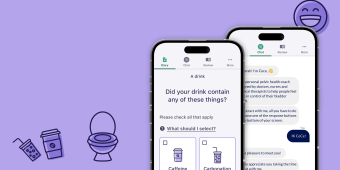Last week, four TXIers traveled to Las Vegas for the 2022 HLTH conference, the healthcare industry’s “#1 innovation event.” We heard from innovators throughout the healthcare space, from groups like the American Medical Association, leading large-scale efforts to drive innovation, to individual “doctor-preneurs” intent on solving a problem they observed firsthand while practicing.
We spent four days talking with people in a variety of roles with varied backgrounds working on vastly different projects. After the initial buzz settled, we recognized that much of what we’d experienced played into three overarching themes, all of which support the idea that, in the future of digital health, we will be able to achieve better outcomes by working together.
Here’s a broad overview of each of these themes and what they mean for those looking to innovate in the healthcare space.
1. In digital health, we are better together
The AMA delivered an excellent keynote that emphasized the importance of including diverse perspectives and prioritizing equity when developing digital health products. Diversity and inclusion are important in any setting where innovation is the goal: the more perspectives involved, the more ideas emerge, and the more ideas you have, the better your shot at having a great idea.
In healthcare, though, including diverse perspectives is even more important than in other industries. That’s because the stakes are much higher. A productivity app that doesn’t take the potential for spotty internet connection into account may see less adoption in rural areas. A blood sugar monitor that makes the same mistake could seriously harm users.
Among those developing digital health solutions, then, there needs to be an increased focus on health equity and access to care––a complex proposition. For example, digital health solutions can help bridge the gap when the closest GI practitioner is 200 miles away. But at the same time, we shouldn’t think of digital care as a one-to-one substitution for in-person care.
Rather, digital solutions should both streamline and augment what's possible with analog possibilities so that providers have more time to spend with patients and patients have more touch points in their care journey.
Yet this doesn’t mean that digital care necessarily means more face-to-face time with providers (either in person or virtually). Digital care touch points may include data gathering, provider review of patient data, and asynchronous communication. This leads (on the positive side) to improved access to the provider for patients. And on the negative side, it can lead to fuller inboxes, more notifications, and more messages for providers to read and respond to.
So digital health solutions need to both improve equitable access to care and help rethink operational models to bring efficiency to providers so they can improve their reach and scale their efforts.
This isn’t to say that the only successful solutions will be universal; in fact, in healthcare, success is measured by making a significant impact, even if it’s for a relatively small group of people. But we can’t begin to prioritize which problems we solve unless we first listen to people from many backgrounds speak about their experiences.
2. To work, digital health solutions must embrace complexity…
It’s important to include input from varied groups of patients when developing digital health solutions, but it’s just as important to remember that patients are not the only intended users of most digital health products.
Providers and clinicians are, in many cases, also primary users. And often, a patient will not have the chance to experience a digital health solution unless it first has provider buy-in.
But what might a provider recommend? Certainly not a solution that isn’t approved by payers or recommended by ACOs. In many cases, providers won’t recommend a solution that lacks FDA approval or at least the support of a rigorous clinical trial.
In other words, the healthcare landscape is complex––and digital solutions make it more so. What was once a relationship among a patient, provider, and facility is expanded to include one or more digital services. Digital solutions that ignore this complexity do so at their own peril; in order to work well and therefore enjoy adoption in the real world of healthcare, they must account for and embrace its complexity.
And the bar is even higher than we’ve acknowledged so far: even if a solution is embraced by users and doctors, even if it gets FDA approval and is put on formulary with major payers, there are still hurdles to clear: will a physician opt to use one more digital solution when they already juggle dozens to do their jobs? Consider: 63 percent of physicians today report feeling burned out. A whopping one in five is planning to leave their practice in the next two years.
We can’t contemplate digital health solutions without thinking about them in the context of not just how they improve care but also how they affect the daily workload of people delivering care.
The patient side of the equation matters just as much. Will a patient download an app to help with diabetes management when they already have one for blood pressure and another for physical therapy?
If all the app does is deliver a single service virtually, the answer is probably no. The move to digitally enabled care has to move beyond access to virtual care. The ultimate goal is for care to be as integrated as possible and to make patient data as accessible as possible.
The pandemic opened the door to this potential reality; now it’s up to innovators in the healthcare space to usher the industry over the threshold, to the fully connected, fully digitally enabled reality on the other side.
These considerations may seem obvious to medical professionals and others within the healthcare system. But often, that’s not who’s trying to develop digital health solutions. Often, tech companies are the ones eager to “disrupt” healthcare. But as Sam Hazen, CEO of HCA Healthcare, pointed out at HLTH, that’s just not possible in healthcare.
What's promising, though, is the potential for those invested in a better future to be better together. Which brings us to our next point.
3. … And the tenets of product innovation
Software developers with no experience in healthcare tend to fail by not understanding the industry’s complexity. But those within the industry looking to build innovative solutions tend to fail by not understanding the core working methods of innovation.
That is, a “doctor-preneur” may recognize a problem and jump straight to building a solution they think will work. This approach is a perfectly reasonable way for a medical professional to approach a problem: their whole career is predicated on them being an expert and knowing how to solve problems.
But it’s also an approach that typically leads to underwhelming solutions that see poor adoption and little utility in the real world.
That’s because expertise is not how innovation works. Innovation requires us to approach an issue with an open mind, willing to be proven wrong over and over. While the doctor may well have noticed a problem that needs to be solved, its manifestation for them, as a practitioner, may be very different from its manifestation for the patients affected. And the solution to that problem may therefore be something the doctor never considered.
That’s why the practice of product innovation explicitly calls for research of affected parties early on. When we tackle a problem with a product innovation approach, we don’t even assume we’re looking at the right problem until we’ve engaged with enough users. And it’s only after we’re confident that we’re addressing the right problem that we engage in the work of developing solutions.
Read more about the path toward innovation in a healthcare setting.
The future of healthcare is a group effort
Health is an incredibly personal thing, but it’s also a force that has huge implications at the population level. As we create the future of healthcare, in which digital health will play an increasingly prominent role, we will be most successful when we work together, sharing our varied expertise and lived experience.
When we do that, we will forge a healthcare system that makes us all better.
Ready to help shape the future of healthcare? Let’s collaborate.




